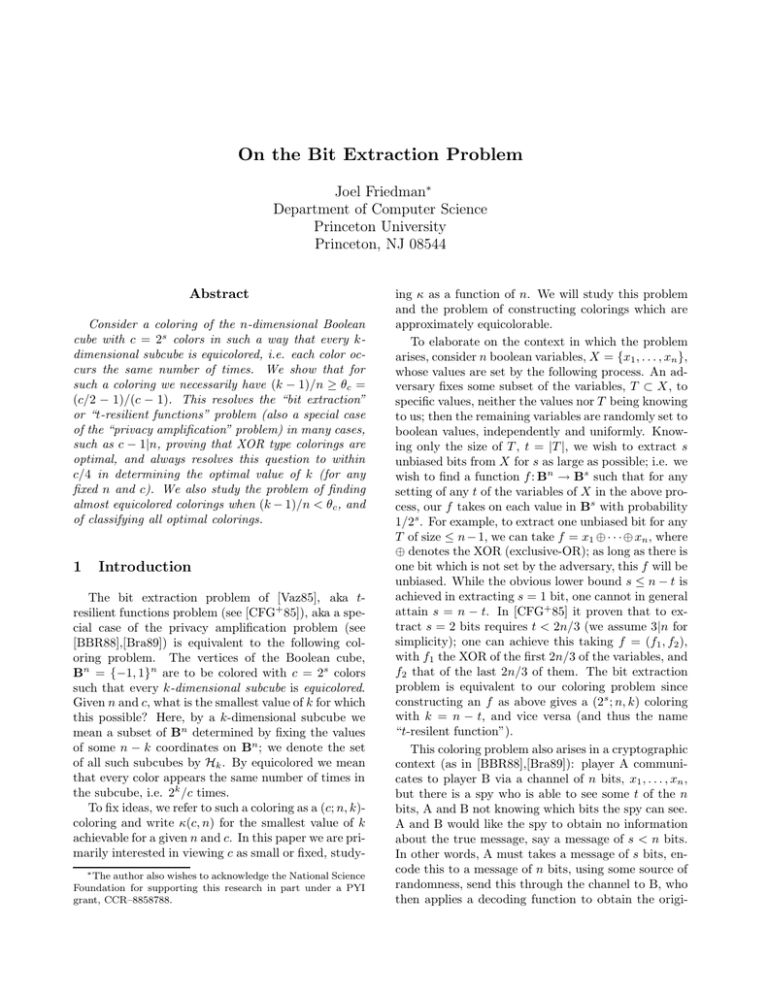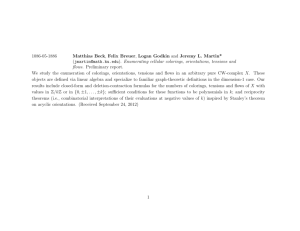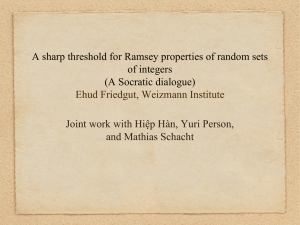On the Bit Extraction Problem Joel Friedman Department of Computer Science Princeton University
advertisement

On the Bit Extraction Problem
Joel Friedman∗
Department of Computer Science
Princeton University
Princeton, NJ 08544
Abstract
Consider a coloring of the n-dimensional Boolean
cube with c = 2s colors in such a way that every kdimensional subcube is equicolored, i.e. each color occurs the same number of times. We show that for
such a coloring we necessarily have (k − 1)/n ≥ θc =
(c/2 − 1)/(c − 1). This resolves the “bit extraction”
or “t-resilient functions” problem (also a special case
of the “privacy amplification” problem) in many cases,
such as c − 1|n, proving that XOR type colorings are
optimal, and always resolves this question to within
c/4 in determining the optimal value of k (for any
fixed n and c). We also study the problem of finding
almost equicolored colorings when (k − 1)/n < θc , and
of classifying all optimal colorings.
1
Introduction
The bit extraction problem of [Vaz85], aka tresilient functions problem (see [CFG+ 85]), aka a special case of the privacy amplification problem (see
[BBR88],[Bra89]) is equivalent to the following coloring problem. The vertices of the Boolean cube,
Bn = {−1, 1}n are to be colored with c = 2s colors
such that every k-dimensional subcube is equicolored.
Given n and c, what is the smallest value of k for which
this possible? Here, by a k-dimensional subcube we
mean a subset of Bn determined by fixing the values
of some n − k coordinates on Bn ; we denote the set
of all such subcubes by Hk . By equicolored we mean
that every color appears the same number of times in
the subcube, i.e. 2k /c times.
To fix ideas, we refer to such a coloring as a (c; n, k)coloring and write κ(c, n) for the smallest value of k
achievable for a given n and c. In this paper we are primarily interested in viewing c as small or fixed, study∗ The author also wishes to acknowledge the National Science
Foundation for supporting this research in part under a PYI
grant, CCR–8858788.
ing κ as a function of n. We will study this problem
and the problem of constructing colorings which are
approximately equicolorable.
To elaborate on the context in which the problem
arises, consider n boolean variables, X = {x1 , . . . , xn },
whose values are set by the following process. An adversary fixes some subset of the variables, T ⊂ X, to
specific values, neither the values nor T being knowing
to us; then the remaining variables are randomly set to
boolean values, independently and uniformly. Knowing only the size of T , t = |T |, we wish to extract s
unbiased bits from X for s as large as possible; i.e. we
wish to find a function f : Bn → Bs such that for any
setting of any t of the variables of X in the above process, our f takes on each value in Bs with probability
1/2s . For example, to extract one unbiased bit for any
T of size ≤ n − 1, we can take f = x1 ⊕ · · · ⊕ xn , where
⊕ denotes the XOR (exclusive-OR); as long as there is
one bit which is not set by the adversary, this f will be
unbiased. While the obvious lower bound s ≤ n − t is
achieved in extracting s = 1 bit, one cannot in general
attain s = n − t. In [CFG+ 85] it proven that to extract s = 2 bits requires t < 2n/3 (we assume 3|n for
simplicity); one can achieve this taking f = (f1 , f2 ),
with f1 the XOR of the first 2n/3 of the variables, and
f2 that of the last 2n/3 of them. The bit extraction
problem is equivalent to our coloring problem since
constructing an f as above gives a (2s ; n, k) coloring
with k = n − t, and vice versa (and thus the name
“t-resilent function”).
This coloring problem also arises in a cryptographic
context (as in [BBR88],[Bra89]): player A communicates to player B via a channel of n bits, x1 , . . . , xn ,
but there is a spy who is able to see some t of the n
bits, A and B not knowing which bits the spy can see.
A and B would like the spy to obtain no information
about the true message, say a message of s < n bits.
In other words, A must takes a message of s bits, encode this to a message of n bits, using some source of
randomness, send this through the channel to B, who
then applies a decoding function to obtain the origi-
nal s bit message; we require a scheme in which the
spy obtains no information about the s bit message.
For example, to communicate one bit, y ∈ B, A can
pick x1 , . . . , xn−1 at random and then set xn to be the
XOR of y and x1 , . . . , xn−1 , which B will decode by
computing the XOR of x1 , . . . , xn . Constructing such
an encoding and decoding for general s turns out to be
equivalent to the coloring problem, again with c = 2s
and k = n − t.
Returning to the coloring problem, consider the colorings by f : Bn → Bs , identifying Bs with the set
of colors, for those f ’s formed by XOR’s of the variables, i.e. f = (f1 , . . . , fs ) with each fi being an
XOR of a subset of the variables; we call such a coloring an XOR coloring. Let κXOR (c, n) denote the
smallest value of k that an XOR coloring can achieve
given c, n. It has been conjectured (e.g. [Vaz85]) that
κXOR (c, n) = κ(c, n) for all c, n, i.e. that that XOR
colorings can always achieve the optimal k; as mentioned before, this was proven for all n with c = 4 in
[CFG+ 85] (and is clear for c = 2).
It is easy to determine κXOR (c, n) to within O(c).
For example, for n divisible by c − 1, it is easy to see
that κXOR (c, n) = nθc +1, where θc = (c/2−1)/(c−1).
It follows that κXOR (c, n) is always within (c − 2)/2 of
nθc + 1.
Here we prove:
Theorem 1.1 For any (c; n, k) coloring we have (k −
1)/n ≥ θc , i.e. κ(c, n) ≥ nθc + 1.
Corollary 1.2 For c − 1|n, n > 0, XOR colorings
are optimal. For any n, c, XOR colorings are within
(c − 2)/2 of optimal.
It is a non-trivial problem to determine κXOR (c, n)
exactly for general n, but one can do so in certain cases
to obtain other bounds as a corollary. For example,
one gets:
Proposition 1.3 For n ≥ 2 and ≡ −2, −1, 0, 1, c/2 −
1, c/2, c/2 + 1 (mod c − 1), we have κXOR (c, n) =
1 + dnθc e and hence = κ(c, n). For n > 2 and ≡ 2
(mod c − 1) with c ≥ 8, κXOR (c, n) = 2 + dnθc e, and
hence κXOR (c, n) is at worst within 1 of κ(c, n). For
c = 8 the former and latter congruences hold according to whether n 6≡ 2 (mod 7) or not. For any n, c,
κXOR (c, n) is within c/4 of κ(c, n).
In particular, n ≡ 2 (mod 7) is the simplest case in
which we don’t know if XOR colorings are optimal.
We are also interested in two related problems:
Problem 1.4 For k < κ(c, n), how close (in various
metrics involving Hk ) to equicolorable can be achieved
by a c-coloring of Bn ?
Problem 1.5 Classify all optimal colorings, at least
for c − 1|n. Are there optimal colorings not obtainable
as XOR type colorings?
The author knows of no optimal colorings other than
XOR colorings. Of course, if one views n and k as
fixed and asks for the optimal c, then there exist
optimal colorings which are not XOR colorings (e.g.
k = (n/3) − 1 with 3|n and n large, so that c = 1 is
the optimal c).
In this paper we study problem 1.4 for the metric
L2 (Hk ) (defined in section 3). We give a lower bound
on the distance to “equicolor” one can achieve for k <
κ(c, n). One remarkable fact is:
Theorem 1.6 For c − 1|n, the optimal XOR coloring
is closest to equicolorable in L2 (Hk ) for any k.
Both this theorem and theorem 1.1 are proven using the eigenvalues and eigenspaces of the adjacency
matrix of the Bn . Such methods can yield other inequalities expressable in terms of the distance distribution (see section 3) of a subset of Bn . For example, the fact that the average influence of a variable
on a boolean function which is 1 on half of the values is at least 1/n (see [KKL88]) follows immediately
from the fact that the
is just
P sum of the influences
P
(n − A)χc , χc = 2n r>0 2rµr ≥ 2n r>0 2µr = 2n ,
using the notation of section 2, where C is the subset
of Bn where the function takes the value 1.
In general, XOR colorings are not closest to equicolor for many important metrics, such as the RP(Hk )
metric defined in section 3 (already for the case n =
c = 4, k = 2). Roughly speaking, the problem is that
for k one less than what can be achieved by the best
XOR coloring for fixed c, n, the best XOR colorings
are equicolored on almost all HHk , but on the other
H’s they avoid half the colors! It would be interesting
to know about the closest to equicolor colorings for
various sup-type norms, such as RP(Hk ) or L∞ (Hk ),
and to give an explicit constructions.
In the proof that XOR colorings are optimal for
c = 4 of [CFG+ 85], one produces from an optimal
coloring f1 , f2 two subsets of variables X1 , X2 whose
XOR’s yield an optimal coloring (any X1 , X2 with the
Fourier coefficient of f1 , f2 , f1 + f2 non-vanishing at,
respectively, X1 , X2 , X1 + X2 will do). This proof
does not directly generalize because of the possibility
of cancellation of Fourier coefficients in computing a
convolution, and theorem 1.1 somehow precludes very
bad cancellation. It would be nice to find a generalization of the method in [CFG+ 85], understanding
precisely how much cancellation can occur in such convolutions. In our paper there is no explicit reference
to Fourier coefficients of the fi ’s. They occur only
implicitly, in that the eigenspace of the adjacency matrix of Bn corresponding to the eigenvalue n − 2r is
precisely the (R-linear) span of the collection of all
XOR’s of r variables.
In section 2 we give a short proof of theorem 1.1
and prove some facts about the optimal XOR colorings, proving proposition 1.3. In section 3 study the
approximate equicoloring problem for L2 . To do so we
study, for a subset C ⊂ Bn , its distance distribution.
It seems that studying “higher-order” distance distributions may shed light on approximate equicolorings
in other norms; for this and other intriguing relations
between the distance distribution and the bit extraction problem, the reader is referred to the full version
of the paper, [Fri91]. In section 4 we make some remarks about problem 1.5, giving a simple geometric
characterization of all XOR colorings.
The author wishes to thank Kai Li, Bernard
Chazelle, and Avi Wigderson for useful comments and
discussions.
2
The Bit Extraction Problem
We begin by proving theorem 1.1. We do this via
a somewhat stronger statement. We say that a subset
C ⊂ Bn is 1/c dense in Hk if
1
|C ∩ H|
=
|H|
c
∀H ∈ Hk .
Theorem 2.1 If there exists a 1/c dense in Hk subset
of Bn , then (k − 1)/n ≥ θc .
Theorem 1.1 follows by taking C to be the set of vertices of any fixed color of a (c; n, k) coloring.
Proof Consider the adjacency matrix, A of the
Boolean cube, and χC , the characteristic function of
C in Bn . Clearly (AχC , χC ) ≥ 0. On the other hand,
the eigenvalues of A are n − 2r with r = 0, 1, . . . n, and
the corresponding eigenspaces, Er , are just the spans
of all XOR’s of r variables, viewing B as {−1, +1}.
It follows that if vr is the projection of χC onto Er ,
then the assumption that C is 1/c dense in Hk implies
that v1 = · · · = vn−k = 0 (and conversely1). Setting
µr = |vr |2 /|χc |2 , we have
P
n
X
|vr |2
µr =
=1
|χC |2
r=0
1 “Conversely”
follows from the invertibility of the standard
2n × 2n Hadamard matrix. In modern lingo, all the weight 1
thru n − k Fourier coefficients vanish for the function taking the
value 1 on C and 0 elsewhere, as in [CFG+ 85], section 5.1.
and
(AχC , χC ) =
n
X
(n − 2r)|vr |2 = |χC |2
r=0
n
X
(n − 2r)µr .
r=0
Also, E0 corresponds to the trivial eigenvector,
(1, . . . , 1), and so µ0 = |C|/n = 1/c; this and µ1 =
· · · = µn−k = 0 give
n
X
0 ≤ nµ0 +
(n − 2r)µr ≤
r=n−k+1
n
X
nµ0 +(2k −2−n)
r=n−k+1
c−1
1
,
µr = n +(2k −2−n)
c
c
and so
c−2
c−1
≥n
,
c
c
which is the desired result.
2(k − 1)
2
We will now evaluate κXOR (c, n) for some special values of n to deduce corollary 1.2 and proposition 1.3. First recall that in general f1 , . . . , fs yield
an Hk equicolored coloring iff all XOR’s of a subsets
of {f1 , . . . , fs } yields a function which is half 1, half -1
on every H ∈ Hk (see, for example, [CFG+ 85]; this is
just to say that the standard 2s × 2s Hadamard matrix is invertible). So for a subset T ⊂ S = {1, . . . , s},
consider the XOR of the fi with i ∈ T , which we denote fT . If the fi are XOR’s of a subsets the variables
X = {x1 , . . . , xn }, then so is each fT . Furthermore, an
XOR of the variables is half 1, half -1 on Hk iff it is the
XOR of at least n − k + 1 variables. This reduces the
analysis of optimal XOR colorings to a question about
the possible Venn diagrams of s subsets, X1 , . . . , Xs ,
of X, Xi being the subset of variables of which fi is
an XOR (which is equivalent to a question about error
correcting codes, as in [CFG+ 85]).
Namely, for a non-empty T ⊂ S, consider the size
of the corresponding component of the Venn diagram
on the Xi ’s,
IT = | (∩i∈T Xi ) ∩ ∩i∈T
/ X i |,
where X i is the complement of Xi in X. The Xi ’s
correspond to an Hk equicolored coloring iff for all
U ⊂ S,
X
IT ≥ n − (k − 1).
(2.1)
|T ∩U|≡1
(mod 2)
Furthermore if there exist non-negative, integral IT
satisfying the above equation with n ≥ k, then clearly
there exists a (c; n, k) XOR coloring.
Summing the above over all U shows that
κXOR (c, n) ≥ 1 + nθc ,
(2.2)
and if equality holds then each of the inequalities of
equation 2.1 holds with equality; the invertibiliy of
the standard Hadamard matrix implies that equality
holding in all the above inequalities necessitates IT =
n/(c − 1). So for c − 1|n, any choice of Xi with IT =
n/(c − 1) for all T yields an optimal coloring, and any
optimal coloring occurs in this way. For c − 1|n we use
the term balanced XOR coloring for any optimal XOR
coloring, to emphasise the fact that all IT ’s are equal.
Furthermore we have
Proposition 2.2 For n ≥ 2 and ≡ −2, −1, 0, 1, c/2 −
1, c/2, c/2 + 1 (mod c − 1), κXOR (c, n) = 1 + dnθc e,
and thus optimal colorings can be achieved by XOR
colorings in these cases.
Proof All cases follow easily from the case n = c/2
and the trivial case n = c − 1. For n = c/2 we take
the “odd coloring,” namely IT is = 1, 0 according to
whether or not |T | is odd. It is easy to see than any
U has |T ∩ U | odd for at least half the T with |T | odd,
and so κXOR (c, c/2) ≤ c/4+1. Rest of details omitted.
2
For general n the problem of determining
κXOR (c, n) is more difficult. However, for fixed c
it suffices to check the cases n = 1, 2, · · · , O(c2 ) to
determine κXOR (c, n) for all n. Indeed, for a fixed
r ∈ [0, c − 2] let K = K(r) be the smallest integer
such that for all m sufficiently large there exists a
(c; (c − 1)m + r, (c/2 − 1)m + K + 1) XOR coloring.
Lemma 2.3 An XOR coloring with IT = 0 for some
T has (k −1)/n ≥ 1/2. For any r there exists a unique
m0 = m0 (r) ≤ 2K(r) − r such that there exist (c; (c −
1)m + r, (c/2 − 1)m + K + 1) for all m ≥ m0 .
Proof The first statement follows from summing over
all U with |T ∩ U | ≡ 1 (mod 2). For the second
part, m0 obviously exists, and the coloring at n =
(c − 1)m0 + r must have at least one IT equal zero,
or else we could subtract 1 from all the IT ’s to get
a coloring as above with m = m0 − 1. So the first
statement applies to yield m0 ≤ 2K(r) − r.
2
In particular, checking κXOR (c, n) for n =
1, 2, . . . , O(c2 ), we can determine all K(r)’s, and therefore all κXOR (c, n) with n ≥ m0 (r)(c − 1) + r = O(c2 )
by the above. Another consequence of the above is:
Proposition 2.4 K(2) = 2 for c ≥ 8, and for n > 2
and ≡ 2 (mod c−1) we have κXOR (c, n) = 2+dnθc e.
Proof K(1) = 1 implies that either K(2) is 1 or
2. The lemma implies that to rule out K(2) being
1 it suffices to check the case m0 = 0, i.e. n = 2,
where there is nothing to check (since 2n < c). Hence
K(2) = 2, and then clearly m0 (2) = 1, i.e. for n = c+1
we can achieve κXOR (c, n) = 2 + dnθc e.
2
Proposition 1.3 is a consequence of the above.
3
Almost Equicolored Colorings and
Profiles
For a c-coloring, γ: Bn → Bs , we define its Lp (Hk )
distance from equicolor via
X
kγ −1 (v)kpLp (Hk ) ,
kγkpLp(Hk ) =
v∈Bs
where for a C ⊂ Bn (and a fixed c = |C|/n in mind)
we define the summand via
p
X kCkpLp (Hk ) =
|C ∩ H| − |H|/c .
H∈Hk
This is one sense in which we can measure how close
to being equicolored a coloring is. In this section we
study the case p = 2. There are other important metrics suggested by the applications, and we mention
kγkRP(Hk ) =
max
H∈Hk ,G⊂Bs ,|G|=2s−1
|γ −1 (G) − 2k−1 | ;
this measures how well the bits γ extracts work as
a random source to an RP algorithm, G being interpreted as the set of witnesses.
We study kCkL2 (Hk ) for a C ⊂ Bn via C’s distance
distribution in the following sense:
Definition 3.1 The distance distribution of a C ⊂
Bn is the collection of numbers, Ni , defined to be the
number of pairs (c1 , c2 ) ∈ C × C of points in C of
distance i (i.e. in the Bn or Hamming distance), for
i = 0, . . . , n.
The Ni is essentially the weight enumerator of coding
theory (see [CS88] or [vL82]).
Consider, for a C ⊂ Bn with |C| = n/c,
X
|C ∩ H|2 .
Ej (C) ≡
H∈Hj
Since
kCk2L2 (Hj ) =
X
(|C∩H|−|H|/c)2 = Ej (C)−
H∈Hj
2n+j n
,
c2
j
(sj (A)f, f ) =
Ej (C) can be used to measure how close C is to being
equicolored with respect to Hj . Routine calculations
demonstrate that one can calculate Ej knowing the
µi ’s of section 2 (see [Fri91] for details):
Lemma 3.2
Ni = (qi (A)χC , χC ) =
n
X
qi (n − 2r)|C|µr
where qi is a polynomial of degree i given by q0 = 1,
q1 (x) = x, and
x
i+1
qi (x)−
n−i+1
i+1
qi−1 (x) (3.1)
for i ≥ 1. Furthermore,
j X
n−l
Nl = (sj (A)χC , χC ) =
Ej =
j−l
l=0
n
X
si (n − 2r)|C|µr ,
r=0
where sj is a polynomial of degree j with leading co−1
, given generally
efficient n(n − 1) · · · (n − j + 1)
as
j X
n−l
(3.2)
sj (x) =
qi (A).
j−l
l=0
The key point in the proof of theorem 1.6 is to
understand the polynomials sj ; they are determined
by the following proposition. The author admits to
having discovered this proposition by example with
computer-aided calculations, which once known is
easy to prove (yet the author knows no direct combinatorial proof using only equations 3.2 and 3.1).
Proposition 3.3 sj has −n, −n + 2, . . . , −n + 2j − 2
as its j roots; i.e.
sj (x) =
(x + n)(x + n − 2) · · · (x + n − 2j + 2)
=
n(n − 1) · · · (n − j + 1)
2j
X
X
H∈Hj
x∈H
!2
f (x)
,
for any f ∈ L2 (Bn ). The right-hand-side of the above
clearly vanishes if f is the XOR of r variables with
r ≥ n−j +1. Since such an f has eigenvalue n−2r, we
conclude that sj has a root n−2r for any r ≥ n−j +1.
2
r=0
qi+1 (x) =
Proof It is clear from the definition of the sj ’s that
they are polynomials of degree j satisfying
(x + n)/2
.
j
From this proposition we see that sj (x) restricted
to x = −n, −n + 2, . . . , n is a convex function, as is its
restriction to [−n + 2j − 2, +∞), and we easily obtain
the following stronger version of theorem 1.6:
Theorem 3.4 For c − 1|n and j ≤ 1 + θc n, the balanced XOR coloring is closest in L2 (Hj ) to equicolor,
and any coloring as close must have the same distance
distribution as that of the balanced XOR coloring. In
other words,
sj (A)χC , χC
1
c−1 ≥ sj (n) +
sj −n/(c − 1) ,
(χC , χC )
c
c
equality holding iff c−1|n and all µi ’s vanish except for
µ0 = 1/c and µn(1−θc ) = (c−1)/c. For c−1 6 |n, setting
−n/(c − 1) = t + α with t an integer and α ∈ (0, 1),
we have the sharper bound
sj (A)χC , χC
1
c − 1
≥ sj (n)+
(1−α)sj (t)+αsj (t+1) ,
(χC , χC )
c
c
with equality iff µt = (1 − α)(c − 1)/c, µt+1 = α(c −
1)/c.
4
Locally Symmetric Colorings and
Concluding Remarks
We consider the problem of classifying for c − 1|n
all optimal colorings, i.e. with k = 1 + nθc . We call a
coloring, γ: Bn → Bs locally symmetric if there is an
η such that for all v ∈ Bn , exactly nη of v’s neighbors
are colored γ(v), and every other color occurs among
v’s neighbors exactly n(1−η)/(c−1) times. In addition
we say that the coloring is sparse if η = 0; the balanced
coloring is an example.
It is easy to see that locally symmetric colorings are
also symmetric in their “distance i neighborhoods” for
all i, and that each color has the same distance distribution which is uniquely determined by η. In particular, a locally symmetric coloring which is optimal for
c − 1|n must be sparse.
These considerations, and theorems such as theorem 3.4 suggest dividing problem 1.5 into two parts:
Problem 4.1 Are all optimal colorings, i.e. with k =
κ(c, n), necessarily locally symmetric, at least if c −
1|n?
2
Of course, in the above proposition, one can replace
the local symmetry condition by the condition that,
say, each v ∈ Bn has all colors appearing among its
neighbors except for, possibly, its own color. Call such
a coloring connected. We can restate the problems as:
Problem 4.4 Is any optimal coloring necessarily
connected and does it necessarily satisfy the above two
conditions?
Problem 4.2 Are all locally symmetric sparse colorings necessarily XOR colorings?
Regarding the latter question, and XOR colorings in general, one can make the following observation. Consider a general cycle of length 4 in Bn ,
(v0 , v1 , v2 , v3 , v0 ). XOR colorings satisfy the following
two conditions:
1. γ(v3 ) depends only on γ(v0 ), γ(v1 ), γ(v2 ), not on
the particular cycle,
References
[BBR88]
C.H. Bennett, G. Brassard, and J.-M.
Robert. Privacy amplification by public discussion. SIAM J. on Computing,
17(2):210–229, 1988.
[Bra89]
G. Brassard.
Cryptology— Column
1. SIGACT News, 20(3):15–19, Summer
1989.
2. γ(v0 ) = γ(v2 ) implies γ(v1 ) = γ(v3 ).
Proposition 4.3 Any locally symmetric coloring satisfying the above two conditions is an XOR coloring.
Proof Fix any coloring, γ, of Bn , and a vertex,
v ∈ Bn . We define a group law on the colors as follows. We can assume η < 1, or else there is nothing
to prove. So for any γ1 6= γ2 neither equal γ(v), there
exist neighbors v1 , v2 of v with γ(vi ) = γi . There exists a unique v3 making v, v1 , v3 , v2 a simple cycle of
length 4; define γ1 + γ2 to be γ(v3 ). If γ1 = γ2 define their sum to be γ(v), and if one of γ1 , γ2 is γ(v)
define their sum to be the other γi . That this defines defines a commuatative, associative group law,
with identity γ(v), and every other element of order
2, is an easy consequence of the above conditions; for
example, commutativity follows from the fact that if
v0 , v1 , v2 , v3 is a simple cycle then so is v0 , v3 , v2 , v1 ; associativity follows from the fact that the sum of three
colors is the antipodal point to v0 in a subcube of
Bn isomorphic to B3 . This sets up an isomorphism
between the colors and Bs . One can similarly show
that for every cycle (v0 , v1 , v2 , v3 , v0 ) we have the sum
of the colors vanishing (i.e. = γ(v)). Setting coordinates on Bn so that v is the origin, the coloring of
the neighbors of v determine XOR’s, f1 , . . . , fs such
that the fi ’s induce the given coloring on v and its
neighbors. The conditions on the coloring imply, by
induction on k, that for any w ∈ Bn of distance k to v,
the coloring determined by the f1 , . . . , fs agrees with
the original coloring.
[CFG+ 85] B. Chor, J. Friedman, O. Goldreich,
J. Håstad, S. Rudich, and R. Smolensky.
The bit extraction problem or t-Resilient
functions. In 26th Annual Symposium on
Foundations of Computer Science, pages
396–407, 1985.
[CS88]
J.H. Conway and N.J.A. Sloan. Sphere
Packings, Lattices, and Groups. SpringerVerlag, 1988.
[Fri91]
J. Friedman. On the bit extraction problem. Technical report, Princeton University, December 1991.
[KKL88]
J. Kahn, G. Kalai, and N. Linial. The influence of variables on boolean functions. In
29th Annual Symposium on Foundations of
Computer Science, pages 68–80, 1988.
[Vaz85]
U. Vazirani. Towards a strong communication complexity theory, or generating
quasi-random sequences from two communcating slightly-random sources. In
Proc. of 17th ACM Symposium on Theory
of Computing, pages 366–378, 1985.
[vL82]
J.H. van Lint. Intorduction to Coding Theory. Springer-Verlag, 1982.





